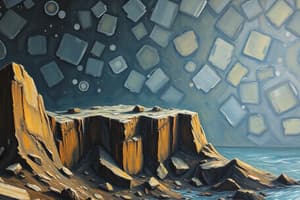Podcast
Questions and Answers
What is the primary cause of earthquakes?
What is the primary cause of earthquakes?
- Movement of tectonic plates
- Erosion of soil layers
- Sudden release of energy in the earth's crust (correct)
- Volcanic activity beneath the surface
Which type of stress causes rocks to be pushed towards each other?
Which type of stress causes rocks to be pushed towards each other?
- Shear stress
- Bending stress
- Tensional stress
- Compressional stress (correct)
What movement characterizes a normal fault?
What movement characterizes a normal fault?
- Rocks are stretched horizontally
- Hanging wall moves upward relative to footwall
- Both walls move parallel to each other
- Hanging wall moves downward relative to footwall (correct)
What type of fault is created when rocks are subjected to shear stress?
What type of fault is created when rocks are subjected to shear stress?
How is an active fault defined?
How is an active fault defined?
What is the distinction of a thrust fault within reverse faults?
What is the distinction of a thrust fault within reverse faults?
Which fault type involves both shear and compression or tension?
Which fault type involves both shear and compression or tension?
What differentiates inactive faults from active faults?
What differentiates inactive faults from active faults?
What is a creep fault characterized by?
What is a creep fault characterized by?
What defines the Philippine Fault Zone (PFZ)?
What defines the Philippine Fault Zone (PFZ)?
Which fault type is the Central Mindoro Fault characterized as?
Which fault type is the Central Mindoro Fault characterized as?
What is the focus of an earthquake?
What is the focus of an earthquake?
Which event is NOT a common cause of tsunamis?
Which event is NOT a common cause of tsunamis?
What magnitude did the strongest recorded earthquake in Southern Chile have?
What magnitude did the strongest recorded earthquake in Southern Chile have?
Which term describes the breaking surface underground in a fault?
Which term describes the breaking surface underground in a fault?
What is the epicenter of an earthquake?
What is the epicenter of an earthquake?
Flashcards
Earthquake
Earthquake
Shaking and trembling caused by the sudden release of energy in the Earth's crust.
Fault
Fault
A fracture or break in the Earth's crust.
Normal Fault
Normal Fault
A fault where the hanging wall moves down relative to the footwall, created by tensional stress.
Reverse Fault
Reverse Fault
Signup and view all the flashcards
Strike-Slip Fault
Strike-Slip Fault
Signup and view all the flashcards
Active Fault
Active Fault
Signup and view all the flashcards
Inactive Fault
Inactive Fault
Signup and view all the flashcards
Stress (geology)
Stress (geology)
Signup and view all the flashcards
Creep Fault
Creep Fault
Signup and view all the flashcards
Trench
Trench
Signup and view all the flashcards
Focus (Hypocenter)
Focus (Hypocenter)
Signup and view all the flashcards
Fault Plane
Fault Plane
Signup and view all the flashcards
Fault Line
Fault Line
Signup and view all the flashcards
Tsunami
Tsunami
Signup and view all the flashcards
Epicenter
Epicenter
Signup and view all the flashcards
Underwater Earthquake
Underwater Earthquake
Signup and view all the flashcards
Study Notes
Earth's Surface Cracks
- Earthquakes: Sudden releases of energy in Earth's crust cause shaking and trembling.
- Faults: Fractures or breaks in Earth's crust.
- Fault zones: Series of associated faults.
- Stress: Force applied to rocks.
- Types of Stress:
- Tensional stress: Rocks stretched apart.
- Compressional stress: Rocks pushed together.
- Shear stress: Rocks pushed perpendicular to the axis.
Faults and Movements
- Dip: Angle of a fault plane.
- Dip-slip faults: Faults formed by the dip, including normal and reverse faults.
- Hanging wall: Part of the fault above the fault plane.
- Footwall: Part of the fault below the fault plane.
- Normal Fault: Hanging wall moves down relative to the footwall due to tensional stress.
- Reverse Fault: Hanging wall moves up relative to the footwall due to compressional stress.
- Thrust fault: Subtype of reverse fault with a dip less than 45°.
- Strike-slip fault: Fault movement along the strike (horizontal).
- Shear: Parallel but opposite movements along the fault plane.
- Left-lateral strike-slip fault: Leftward movement of one side relative to the other.
- Right-lateral strike-slip fault: Rightward movement of one side relative to the other.
- Shear: Parallel but opposite movements along the fault plane.
- Oblique-slip fault: Movement along both dip and strike directions, combining shearing and compression/tension.
Active and Inactive Faults
- Active faults: Generated earthquakes within the last 10,000 years and may continue to do so.
- Shallow earthquakes occur on active faults.
- Inactive faults: No record of generating earthquakes in the last 10,000 years, but may generate earthquakes in the future.
- Creep fault: Fault movement without associated earthquake activity.
- Trenches: Long, narrow, and steep-sided depressions in the ocean floor.
- Philippine Trench: Deepest trench in the Philippines, third deepest globally.
- Philippine Fault Zone (PFZ): Major tectonic feature crossing the Philippines (northwestern Luzon to southeastern Mindanao), 1200 km long, composed of many faults.
- Central Mindoro Fault: Right-lateral fault marking a slope break.
- Lubang Fault: Left-lateral fault offshore between Batangas and Mindoro.
Anatomy of an Earthquake
-
Focus/Hypocenter: Point where rocks first break, releasing seismic energy.
-
Fault plane: Breaking surface underground.
-
Fault line: Edge of the fault plane.
-
Fault scarp: Exposed fault plane above the ground, indicating a fault.
-
Epicenter: Point on Earth's surface directly above the focus; the strongest earthquake point.
-
Types of Earthquake According to Depth of Focus: (related information omitted in the text).
All About Tsunamis
- Tsunami: Large volume of water reaching the surface, triggered by underwater events.
- Causes of Tsunamis:
- Underwater earthquakes.
- Volcanic eruptions.
- Nuclear explosions.
- Meteors.
- Underwater landslides.
- Strong Tsunamis:
- Tohoku, Sendai (Japan) - March 11, 2011: 9.0 magnitude.
- Southern Chile - May 22, 1960: Strongest earthquake, 9.5 magnitude.
- Northwest Sumatra (Indonesia) - December 26, 2004: 9.3 magnitude underwater earthquake.
Studying That Suits You
Use AI to generate personalized quizzes and flashcards to suit your learning preferences.




